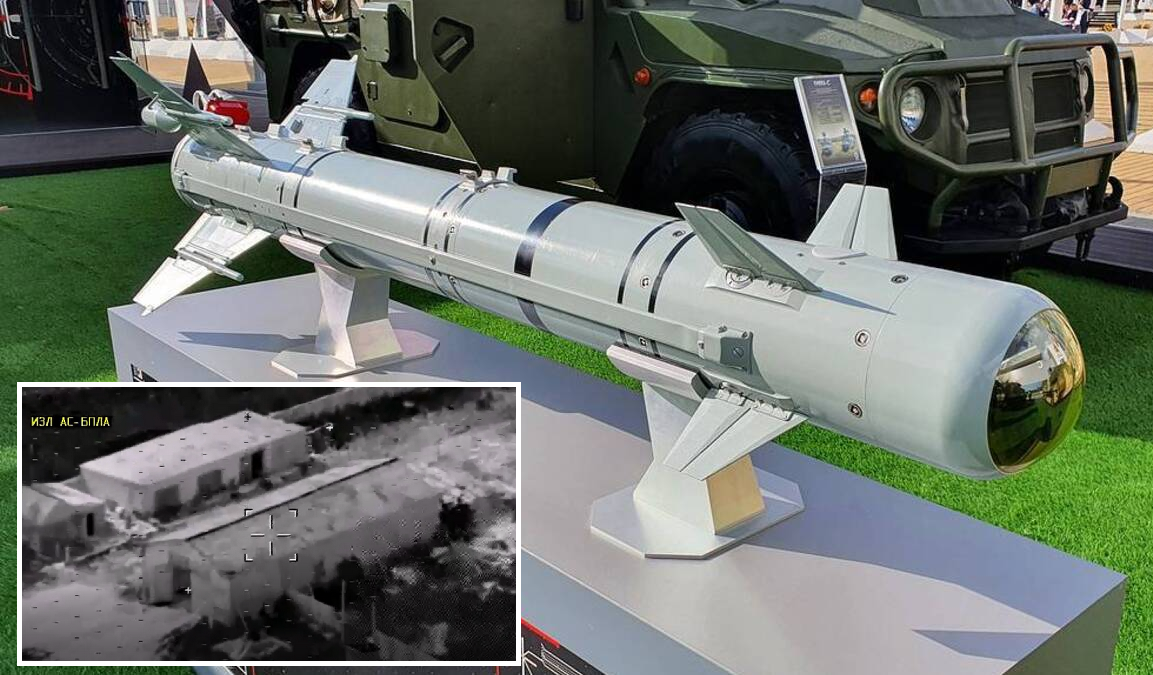Few Russian weapons systems have managed to impress international audiences during the 2022 Russo-Ukrainian War. Though this is partially the result of decades of hyping up Russian weapons systems to standards they could never live up to by Western think tanks, Russia also failed to timely invest in certain technologies and thus is a latecomer to systems such as unmanned combat aerial vehicles (UCAVs) and loitering munitions. Despite having designed a host of guided weapons systems, few were ever acquired by the Russian Air Force in any meaningful numbers, which mostly continues to make use of 1980s-era Kh-25s and Kh-29s and even unguided bombs. Even Russia's most modern precision-guided munitions (PGMs) have been observed to be lacking in accuracy, especially compared to Western PGMs.
The first departure from this trend came in June 2022, when a new type of PGM was seen striking a small house purportedly housing Ukrainian troops. [1] The air-to-ground missile (ASM) used was quickly identified as the Izdeliye 305 (LMUR), a newly-developed weapon that can strike targets at ranges in excess of 15km. The LMUR can hit targets marked by a helicopter, which can then relocate while the
missile seeker continues to track the target until it hits, or it can be launched from farther afield, with the operator using a datalink to guide the missile to its target (which also allows the operator to switch targets during flight). Both operating methods are a great improvement over older-generation Russian helicopter-launched ATGMs/ASMs, for the use of which helicopters generally have to hover in position, making them easy targets.
The Izdeliye 305 was first readied for series production in November, 2014, though an oversight on the part of the Russian MoD to also order a launcher meant that the project was left in limbo before the contract was terminated in 2017. [2] The
LMUR project was saved by the Federal Security
Service (FSB), which
wanted a long-range ASM for its Mi-8MNP-2 attack helicopters for counterrrorism operations in the Caucasus. The Izdeliye 305 can be launched from the APU-305 single-rail launcher or the two-round APU-L launcher from the FSB's Mi-8MNP-2s and the Russian Air Force's Mi-28 and
Ka-52 attack helicopters. A ground-based launcher codenamed Baikal was once also envisaged. [2]
Widespread introduction of the LMUR is likely preempted by its prohibitively large costs. In 2018, one LMUR missile costed $227,000 for the
Russian Ministry of Defense, while the price of the missile's export variant would certainly be even higher. [2] In Ukraine, the LMUR has mostly seen use against buildings suspected of hiding Ukrainian equipment and troops, pontoon bridges and Ukrainian vehicles situated near pontoon bridges. Though these can be struck with high precision, the LMUR's 25kg warhead would require a very lucky hit to kill Ukrainian troops in a structure as large as a warehouse. [3] The Russian MoD has also used one LMUR video to provide evidence of the purported destruction of two HIMARS on the second floor
of a three-story office building – a rather unconvincing hiding place for
the truck-based rocket launchers. [4]
 |
An Izdeliye 305 installed on a dual APU-L pylon fitted to an Mi-28 attack helicopter. |
A list of Ukrainian targets visually confirmed to have been struck by Russian Izdeliye 305 (LMUR) ASMs can be viewed below. This
list only includes targets of which videographic evidence is available. Therefore, the
amount of equipment destroyed is likely higher
than recorded here. The list will be updated as additional footage
becomes available.
(Click on the numbers to get a picture of each individual equipment or building)
Armoured Fighting Vehicles (5)
 1 MT-LB armoured fighting vehicle: (1, destroyed near a pontoon bridge)
1 MT-LB armoured fighting vehicle: (1, destroyed near a pontoon bridge) 1 BMP-2 infantry fighting vehicle: (1, destroyed near a pontoon bridge)
1 BMP-2 infantry fighting vehicle: (1, destroyed near a pontoon bridge) 1 BTS-4 armoured recovery vehicle: (1, destroyed near a pontoon bridge)
1 BTS-4 armoured recovery vehicle: (1, destroyed near a pontoon bridge) 1 IMR-2 combat engineering vehicle: (1, destroyed near a pontoon bridge)
1 IMR-2 combat engineering vehicle: (1, destroyed near a pontoon bridge) 1 Unknown IMV: (1, destroyed near a pontoon bridge)
1 Unknown IMV: (1, destroyed near a pontoon bridge)
Vehicles (2)
 1 KrAZ-255B dump truck: (1, destroyed near a pontoon bridge)
1 KrAZ-255B dump truck: (1, destroyed near a pontoon bridge) 1 4x4 truck: (1, destroyed near a pontoon bridge)
1 4x4 truck: (1, destroyed near a pontoon bridge)
[2] Is Russia Using Its New Advanced Anti-Armor Missile In Ukraine? https://www.thedrive.com/the-war-zone/is-russia-using-its-advanced-new-anti-armor-missile-in-ukraine
Special thanks to Rob Lee.
Recommended Articles:
The Oryx Handbook of Iranian Drones

.png)





